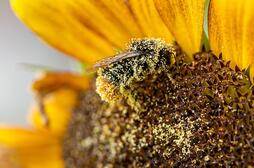 Most flowers smell delightful and lure in pollinators, like bees and butterflies. The pollinators sip the flowers' sweet nectar, while the plants get fertilized. But not every potential pollinator is seduced by a sweet fragrance. 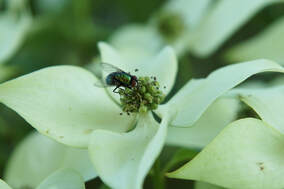 Some plants have evolved specialized scents to attract other insects. Flies are effective pollinators, but they aren't attracted to sweet smells. They like flowers that waft a funkier stench.  Some of them are listed below. You wouldn’t want them in your next birthday or Valentine's Day bouquet. These are some stinky blooms. Also, be sure to check out my TikTok for videos on all 10 poop flowers listed below! Symplocarpus foetidus, Eastern skunk cabbage 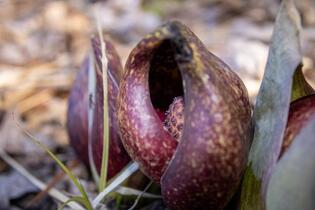 Skunk Cabbage grows naturally in the wetland soils of eastern North America. Breaking or tearing a leaf produces a pungent but harmless odor, the source of the plant's common name. It is also foul smelling when it blooms. The odor attracts its pollinators: scavenging flies, stoneflies (like Calliphora vomitoria), and bees. 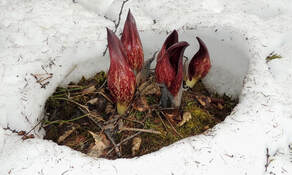 Eastern Skunk Cabbage is notable for its ability to generate temperatures of up to 59–95°F above air temperature by cyanide resistant cellular respiration. It is a thermogenic plant, melting its way through the frozen ground. It sprouts a large mottled, maroon-colored hood-like flower while snow still blankets the ground. The flower is pollinated by insects that likewise emerge at this time. The skunk cabbage’s scent, as well as its heat, attract its carrion-feeding, pollinating insects. 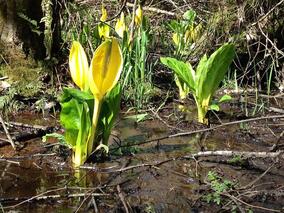 Eastern Skunk Cabbage has roots which contract after growing into the earth, pulling the stem deeper into the mud. Each year, the plant grows deeper, so that older plants are practically impossible to dig up. They reproduce by hard, pea-sized seeds which fall in the mud and are carried away by animals or by floods. 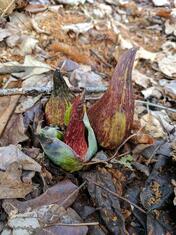 Skunk Cabbage often contains calcium oxalate crystals, and therefore the plant is considered to have medium toxicity to humans. The toxicity may be removed through careful preparation. 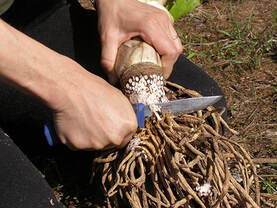 Various Native American tribes used Skunk Cabbage extensively as a medicinal plant, seasoning, and magical talisman. Dried young leaves may be used in soups and stews. Dried rootstocks can be made into a cocoa-like flour. Hydnora africana, Jackal Food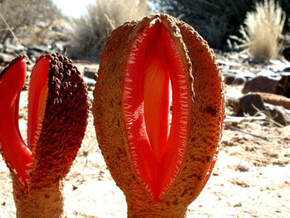 Hydnora Africana is a parasitic plant that grows entirely underground except for a fleshy flower, which resembles female genitalia. The plants emit an odor of feces to attract pollinators, dung and carrion beetles, which become trapped within the flowers. During their entrapment, the beetles pollinate the flowers. 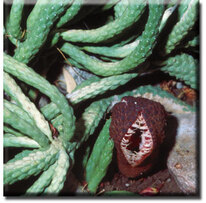 The root-like structures of Hydnora africana intertwine with the root system of host pants in the Euphorbia genus and absorb their sugars, minerals, and water. That is the only way Hydnora africana can survive because it has no chlorophyll. Jackal food has a fleshy look and feel, much like a fungi. In fact, its genus name Hydnora, means fungus-like. 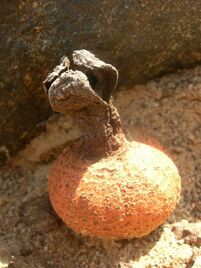 Hydnora africana produces a fruit, the jackal food, an underground berry with a thick, leathery skin and lots of seeds embedded in the jelly-like pulp. It is eaten by animals, as well as people. It is extremely astringent and has been used for tanning, preserving fishing nets, and treating acne in the form of face wash. The fruit has also been used to treat dysentery, kidney, and bladder ailments. Bulbophyllum phalaenopsis, Bucky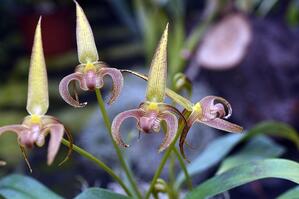 Bulbophyllum is a genus of orchid which lives on other plants or on rocks. The genus is pantropical and widespread, occurring in Australia, Southeast Asia, India, Madagascar, Africa, Central and South America. 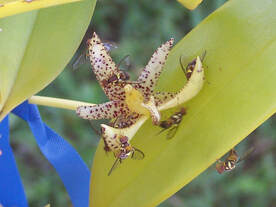 Bulbophyllum attracts hordes of flies for pollination. They are drawn to the varying odors that different species produce, including those resembling sap, urine, blood, dung, carrion, and, in some species, fragrant fruity aromas. The odor a blooming plant puts off is overpowering. 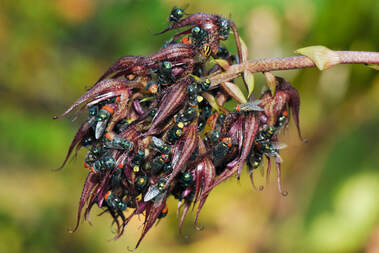 And the really bad news is these plants are ever-blooming, flowering continuously throughout the year. Given their odor, few people would want them in their home, which is good, because they require a controlled growing environment and are difficult to cultivate, making them ill-suited as houseplants. Helicodiceros muscivorus, Dead Horse Arum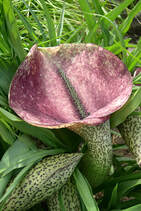 The Dead Horse Arum lily is an ornamental plant native to Corsica, Sardinia, and the Balearic Islands, between Italy and Spain. The inflorescence of arum lilies resembles the anal area of a dead mammal. There is a hairy tail-like spathe running down into the chamber of the flower. 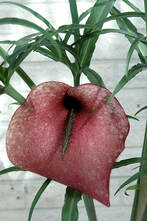 Dead Horse Arum manipulates the heat to release an odor that lures flies to begin pollination. The plant has a two-day process for pollination. An individual flower’s female parts can only receive pollen for one day, and its male parts are not mature that day. The male parts can produce pollen the next day, but the female part shrivels up and cannot receive it. These mechanisms encourage cross-pollination rather than self-pollination. 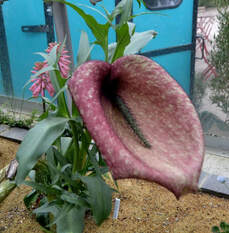 On a clear, sunny day, when the plant is ready to pollinate, it produces its own heat and generates a smell like rotting flesh. This smell attracts blow flies into the chamber of the plant for pollination. The odor is strong and the flies can’t distinguish between the flower and a real carcass. Flies find the smell and the flesh-colored hairy inflorescence of the plant irresistible. Many flies are attracted to the blooms. 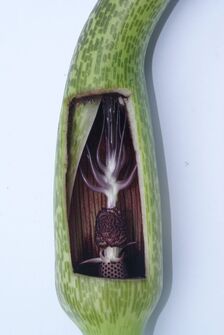 Once the flies are inside, they are trapped in the chamber by spines that block the exit path. The flies, which are carrying pollen from previous visits to other flowers, cover the female floret with that pollen, as they try to find a place to lay their eggs. The flies remain trapped overnight, and the spines remain erect until the male florets at the entrance of the chamber start producing pollen, by which time the female florets are no longer receptive. At this point, the spines wilt and the flies are able to leave. Just as the flies leave, they have to pass through the male florets and are coated with pollen that they will transport to another plant. Some blowflies, such as Calliphora vomitoria, are known pollinators. Dracunculus vulgaris, Vampire Lily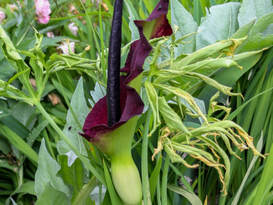 Dracunculus vulgaris is a perennial. It was originally found in Greece and has been introduced to other parts of Europe and North America. These plants can grow up to 6 feet tall and boast elongated, broad leaves. 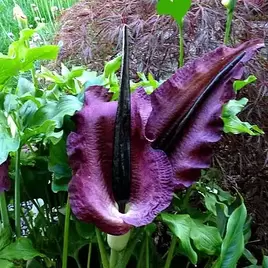 The pseudo-flower of the Vampire Lily is a large, purple or maroon conical bract or spathe. Inside the spathe is a long, black appendage called the spadix or appendix that contains the inconspicuous, actual male and female flowers. 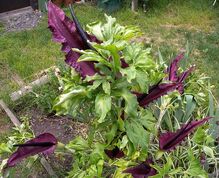 Dracunculus vulgaris releases the smell of rotting meat to attract flies for pollination. Though a fascinating flower to look at, it is best kept away from windows, doors, or pathways to prevent the scent from wafting toward on comers. 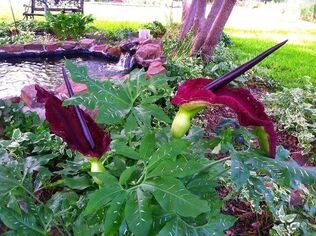 Despite its exotic appearance, the Vampire Lily is easy to care for. These plants are naturally found by rivers, ponds, and forest edges and grow from buried tubers. Besides consistent watering, Vampire Lilies don’t demand much maintenance. When they receive plenty of sunshine and water, these stunning plants will bloom abundantly. 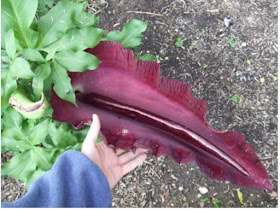 When touched, Dracunculus vulgaris can cause skin irritation, so be sure to wear gloves when handling it. (Not like in this photo!!) The plant is also toxic to animals if ingested. But animals do not typically come near it because of its noxious smell. Ceratonia silique, Carob Tree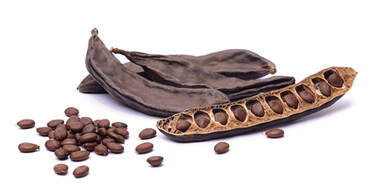 The carat, a unit of mass for gemstones and a measurement of purity for gold, takes its name from the Greek word for a carob seed, keration. In ancient times, carob seeds were used to measure weight because of their uniformity. Pure gold Roman coins weighed 24 carob seeds. This is the reason that 24 carat is the definition of pure gold. 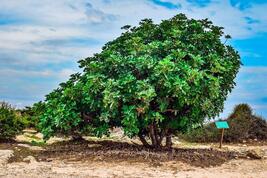 Carob Trees are native to the Mediterranean region. They are members of the legume family, Fabaceae. Not necessary as a standard measure of weight, today, Ceratonia silique is cultivated for its edible pods and as an ornamental tree. 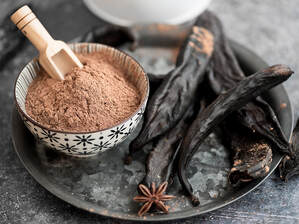 The ripe, dried, and toasted pods can be ground into carob powder and used as a chocolate alternative in most recipes. Unlike the cocoa tree, seedpods of the Carob Tree are safe for animals to consume. Also, unlike cocoa, the husk and seeds do not contain stimulants, such as caffeine or theobromine. 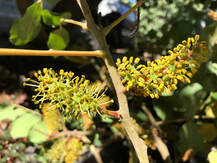 A few Carob Tree cultivars have both male and female flowers and can self-pollinate. Most Carob Trees are either male or female. Although different, both male and female flowers have course bottle-brush structures. 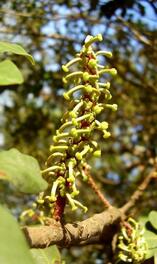 Of the two, only the female trees produce pods, but male or hermaphroditic trees must be nearby for pollination of female trees to occur. Pollination is achieved by wind and insects. 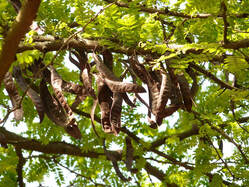 Both self-fruitful and male Ceratonia silique will smell when flowering. The flowers smell like human semen! The compounds that produce the odor are derived from ammonia. Stapelia gigantea, Zulu Giant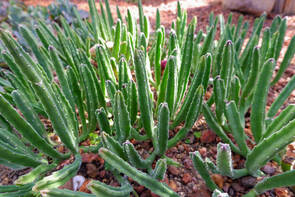 Stapelia gigantea is a species of flowering plant native to the desert regions of South Africa to Tanzania. It is a clump-forming succulent. The plant can become invasive when introduced in other arid and semi-arid environments. 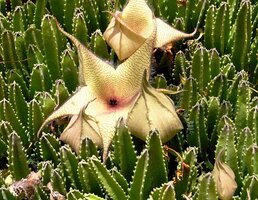 The flowers are red and yellow, wrinkled, with a silky texture and fringed with hairs. They bloom in autumn, triggered by the shorter daylight hours. 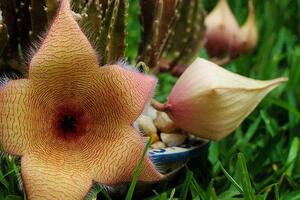 The blooms are large. They have five petals that open in a star shape that is nearly 10 inches in diameter. Zulu Giant in bloom smells of rotting flesh. It is this odor that attracts their fly pollinators. 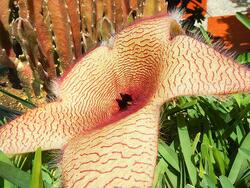 The large size and color of the flowers, combined with the carrion smell, may cause flies to behave as if they are actually a dead carcass, and be more likely to visit. Because of the foul odor, Zulu Giant can act as an appetite suppressant in humans. Valeriana officinalis, Garden Heliotrope or Common Valerian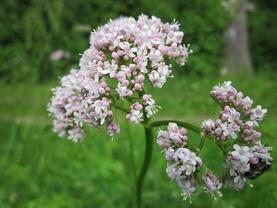 Valeriana is a genus of perennial flowering plant native to Europe and Asia. They are hardy and widespread in the northern hemisphere, encompassing more than 400 species. Valerian grows more than six feet high and may reproduce vegetatively with underground rhizomes or through pollination and seed production. 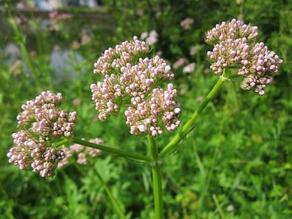 Valerian has been used as an herb in traditional medicine since at least the time of ancient Greece and Rome. Today, Valeriana officinalis root extract is an approved over-the-counter medicine in Germany, Switzerland, Belgium, Italy, and France for the treatment of stress and nervous tension, disturbed sleep patterns, and anxiety. The FDA has not approved it for any medical use; Valerian is sold only as an herbal supplement in the US.  The roots and leaves of Valerian cause a catnip-like response in cats. Rats are attracted to it, as well. Legend has it that the Pied Piper carried Valerian as he led the rats out of Hamelin, a town in Germany. 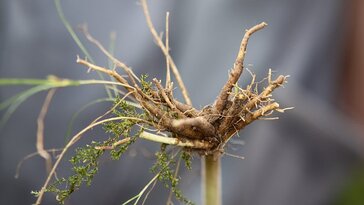 Valerian flowers are pink or white and attract many fly species. Some find their smell intensely sweet. However, Valerian roots have been called “stink root” for emitting the odor of sweaty feet. Ancient Nordic Peoples hung Valerian above their doors to ward against bad spirits, who were apparently driven off by the pungent smell. Eryngium, Sea Holly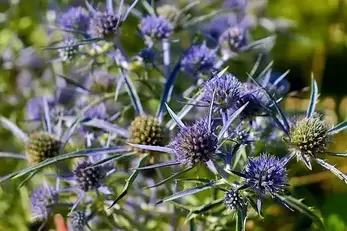 There are about 250 species of Eryngium. The name of this genus refers to its supposed efficacy in digestive disorders. Eryngium is a modification of the Greek word for belching. 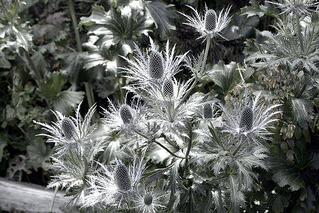 Historically, the herb has been used to treat various urinary tract conditions, breathing problems, skin disorders, and as an aphrodisiac. As with other dietary supplements, there is not enough scientific information to determine if these uses for Sea Holly are safe. Be sure to consult a healthcare professional before using Eryngium to treat any disorder. 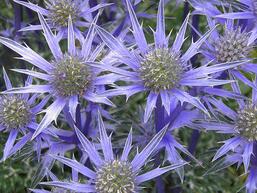 Eryngium species may be either annual or perennial herbs with hairless and usually spiny leaves. The prickly blossoms are pollinated by flies. They smell like dog or cat poop, so when they are included in flower arrangements, the pollen must first be washed off. Corpse Flowers (Titan arum & Rafflesia arnoldii) Rafflesia arnoldii and Titan arum both are giant flowers. They both give off a rotten smell, like a cadaver, so both are nicknamed "corpse flower". The odor's function is to attract beetles and flies to pollinate. Both plants grow in the Sumatran rainforest. 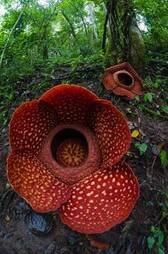 Rafflesia are parasites of lianas, woody vines, in the genus Tetrastigma. Their orange and yellow blooms can be three feet in diameter, with buds rising directly from the ground or from the lower stems of their host plants. Despite its unsavory stench, Rafflesia arnoldii is considered one of the national flowers in Indonesia, where it is a protected species. 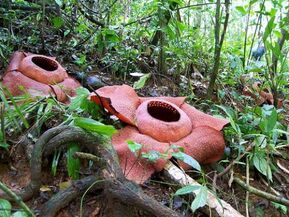 Since its host, Tetrastigma, only grows in primary rainforests, Rafflesia can’t be cultivated. The flowers take months to develop and the bloom lasts just a few days, so they are rare finds. As the remaining primary rainforests of Borneo and Sumatra disappear, the numbers of Rafflesia arnoldii are likely declining and may be approaching extinction. 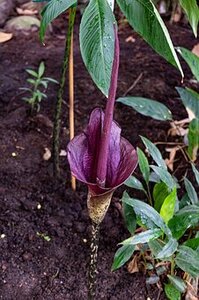 Unlike Rafflesia, Titan arum is a plant which grows from a tuber. Its vase-like exterior, or spathe, contains thousands of flowers. Inside, the plant has a deep red, raw meat color. Titan arum's bloom lasts only 24 to 48 hours and it only blooms once every four to six years. Titan arum can be cultivated, which it why it can be found in many botanic gardens around the world. Have You Ever Smelled Any of These Stinkers? Symplocarpus foetidus, Eastern Skunk Cabbage: Zones 6 - 9 Hydnora africana, Jackal Food: Zones 1-3 Bulbophyllum phalaenopsis, Bucky: Zones 9a - 12b Helicodiceros muscivorus, Dead Horse Arum: Zone 7a Dracunculus vulgaris, Vampire Lily: Zones 7 - 10 Ceratonia silique, Carob Tree: Zones 9 - 11 Stapelia gigantea, Zulu Giant: Zones 9a – 11b Valeriana officinalis, Garden Heliotrope or Common Valerian: Zones 4 -9 Eryngium, Sea Holly: Zones 4-9 Corpse Flowers (Titan arum & Rafflesia arnoldii): Zone 10 I live in Zone 5. I have seen and whiffed skunky smelling Skunk Cabbage and doo-doo stinking Valerian. I had a Zulu Giant as a houseplant. It bloomed once and I never noticed a smell! I will be on the lookout for odiferous Sea Holly. Which of these poopy stinkers have you smelled?
0 Comments
Leave a Reply. |
AuthorGertrude Katz has spent over 30 years teaching K-12 public school students all major subjects. She has taught biology and education at the college level. The majority of her career has been spent instructing biology at the secondary level. Categories
All
|


 RSS Feed
RSS Feed